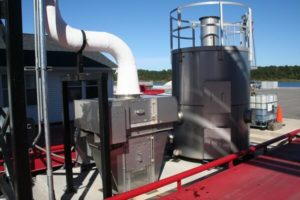Project Overview

Emissions were causing serious problems for a large asphalt terminal located near a residential neighborhood. Elevated concentrations of hydrogen sulfide (H2S) and VOCs were creating offensive odors, which bothered residents in the area. Visible emissions were also an issue. Located at the asphalt terminal are five large storage tanks, which hold asphalt at temperatures in the range of 225-300ºF. Each tank has a breather vent in the roof, which allows vapors containing H2S, mercaptans, and VOCs to escape as the tank breathes and fills. This emission was the primary source of the problematic odor. A system was needed to remove the H2S and other odorous compounds from the discharged air.
The tank emissions were not the only issue for the asphalt terminal. Emissions were also a problem for the truck loading rack, where the asphalt is loaded into tank trucks for local distribution. H2S concentrations and visible emissions were in violation of acceptable regulatory levels at each loading station. A solution was needed for this issue as well.
Among the project objectives were:
- Resolution of the odor complaints from the neighbors and municipality
- Elimination of employee and truck driver exposure to H2S and odors
- Elimination of visible emissions / opacity caused by the mist of condensed hydrocarbons
- Implementation of a proven, reliable, and low maintenance, allowing continuous 24/7 operation with no downtime
Comparison of Alternatives
The company had three options for proper control of the emissions for each of the applications:
- APC’s Ultra High-Efficiency Filter (UHF®) unit, for removal of the fine oil mist followed by a CarbonPure activated carbon adsorption system (for removal of H2S and odors)
- A thermal oxidizer
- A fiber-bed type filter followed by carbon adsorption system
Option 1
The filter-carbon system option consisted of a UHF® unit followed by a CarbonPure activated carbon adsorption system. UHF® filter units are specifically designed for applications with very fine, sticky condensed fumes and particulate such as condensed asphalt fumes. The unit uses dry filter media in roll form, providing very high removal efficiencies (i.e., 98-99%+) including on submicron particulate. Submicron droplets collected by the filter combine to form large raindrop-sized droplets, which collect in the bottom tank of the filter unit. The filter resists plugging and maintains steady air flow by automatically advancing a clean section of filter media into the filtration chamber when the previous filter section becomes caked and is no longer effective. This allows the unit to operate within a steady differential pressure band and air flow rate band until the entire roll is used. Filter rolls are changed in a few minutes with no system downtime. After passing through the UHF® unit, the exhaust gas would pass into the CarbonPure vessel containing two activated carbon beds in series for removal of gas-phase H2S and other odorous compounds.
Option 2
The company had serious reservations around the thermal oxidizer due to the significantly higher capital and operating costs. They were also concerned about the fire risk associated with oil mist collecting in the system and catching fire. A high efficiency pre-filter such as the UHF® filter would be needed to remove the oil mist prior to any oxidizer system.
Option 3
The third option, using a fiber bed type filter in lieu of the UHF® filter, came with considerable maintenance concerns; especially considering the asphalt products involved. When a solid or semi-solid material is present in the exhaust, this type of filter blinds and plugs, choking off air flow and requiring frequent filter change-out, even with a prefilter present. The weight of the fiber filter elements was also a concern as a crane would be required for change-out, and the process is very messy. In contrast, the UHF® unit filters weighed in the range of 50 lbs. (spent) and can easily be handled by one or two people in a few minutes. The maintenance of fiber bed type filters was a concern for the company since they did not have a large staff at the facility.
The Solution
The company had learned of APC’s UHF® system from another large asphalt distributor, who had excellent results with the UHF® system at multiple terminals. Subsequently the first option was chosen to manage both the asphalt storage tank vent emissions and the asphalt loading emissions.The proper volumetric air flow rate was identified, the ductwork system designed, and the filter-carbon system comprised of the UHF®filter system followed by the CarbonPure system containing two types of activated carbon was installed.
In each application, the UHF® filter unit removes and collects substantial amounts of condensed hydrocarbons (i.e., oil) in its bottom tank, providing important protection for the downstream activated carbon unit. In both applications, the elevated H2S concentrations, VOCs, and the aggressive odors were eliminated. Odor complaints from neighbors were resolved, and the local municipality approved the site’s operations once again.

